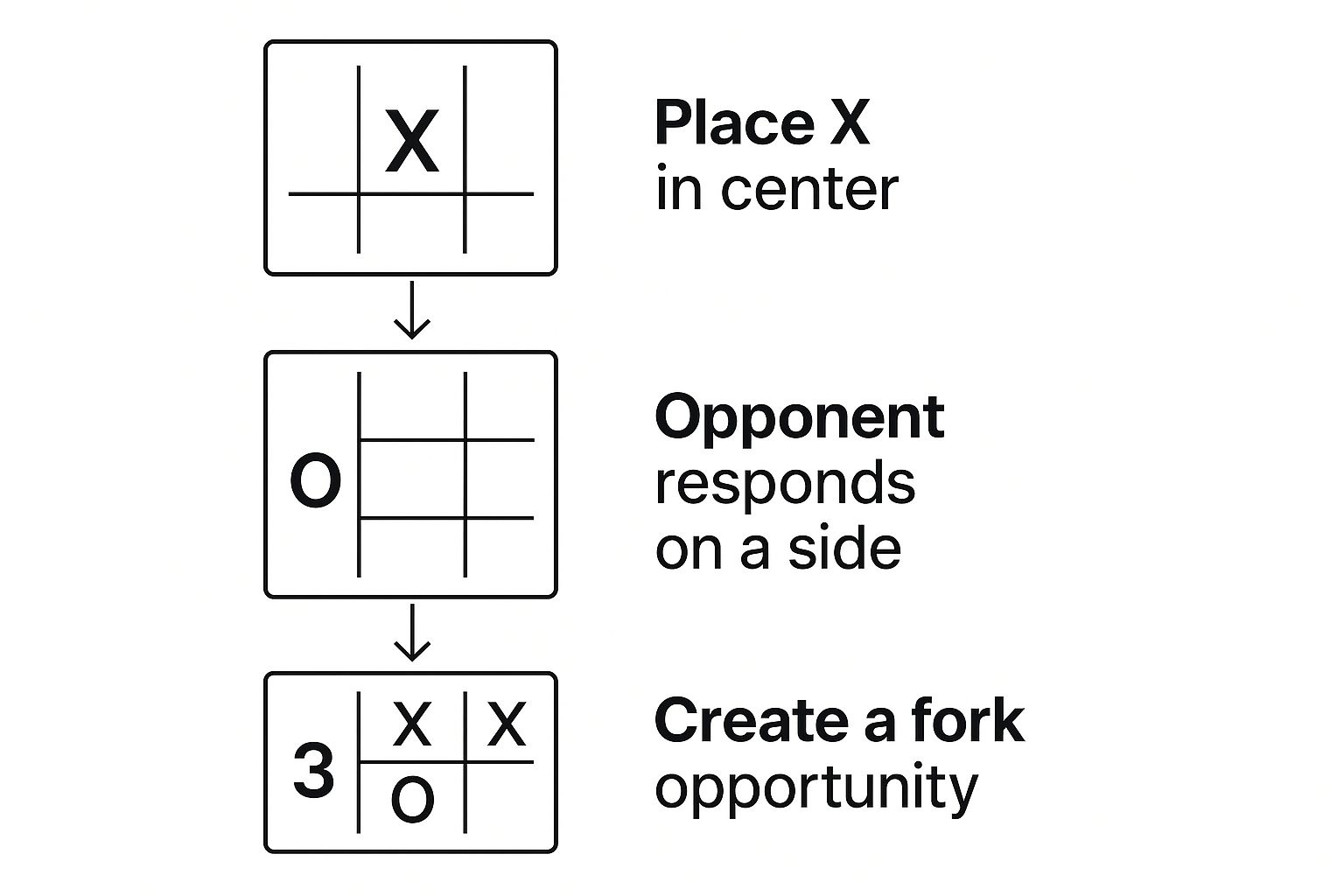Here’s the simple truth about winning at tic-tac-toe: if you're up against someone who also plays perfectly, you can't guarantee a win. But what you can do is guarantee you will never lose. Real mastery of the game comes from understanding the strategy so well that you can force a draw every single time.
The Unbeatable Tic-Tac-Toe Strategy Explained
Tic-tac-toe isn't a game of luck. It's what game theorists call a "solved game," which means there's a mathematically proven path to a predictable outcome. When both players make the best possible move every turn, the game will always end in a tie. Your goal is to become that perfect player, recognizing the optimal move in any situation. This ensures you can either capitalize on an opponent's error to snatch a win or, at worst, walk away with a draw.
This isn't just an abstract concept. Simulations have run the numbers, and an expert player who goes first against a random opponent wins an incredible 97.8% of the time. That statistic alone shows just how powerful a solid strategy can be.
Optimal Opening Moves and Responses
The road to an unbeatable record starts with the very first move—yours and your opponent's. Some opening moves are just flat-out better than others, immediately putting pressure on the other player to respond correctly. In my experience, the most common reason people lose is a simple mistake in the first couple of turns. Getting a feel for these crucial exchanges on one of our premium tic-tac-toe sets can elevate a simple game into a genuine test of strategic thinking.
The name of the game is control. Whether you're X or O, your job is to dictate the game's tempo. You want to force your opponent onto the back foot, making them react to your threats instead of building their own.
Let’s break down the most effective opening moves and the non-negotiable responses needed to stay in the game.
Optimal Opening Moves and Responses
This table outlines the best first moves for Player 1 and the critical responses Player 2 must make to avoid falling into a losing position.
| Player 1's First Move | Player 2's Optimal Response | Strategic Goal |
|---|---|---|
| Corner Square | Center Square | Neutralize the strongest attack and prevent easy forks. |
| Center Square | Any Corner Square | Seize a powerful position and limit Player 1's options. |
| Edge Square | Center, an adjacent corner, or the opposite edge. | Block immediate threats and prepare for counter-attacks. |
Internalizing these opening sequences is the first and most important step. Get these right, and you're already playing at a level most people never reach.
Mastering the First Move: The Offensive Playbook
Going first as Player 1 (X) gives you a significant edge. Your job is to press that advantage from the very first mark, forcing your opponent to react to your moves rather than develop their own strategy. The secret to ensuring you either win or draw every game starts right here.
While you can technically place your first X anywhere, some opening moves are far more powerful than others. From my experience, nothing beats starting in a corner. It's the strongest offensive play you can make.
Placing your X in a corner immediately opens up three potential winning rows. An edge spot, by comparison, only offers two paths, and the center, while a solid choice, plays out quite differently.
Capitalizing on a Corner Start
Let's walk through a classic game scenario. You place your X in the top-left corner. An inexperienced opponent might respond by placing their O on an adjacent edge, say, the top-middle square. This is a critical mistake, and it's your chance to seize control.
Your next move should be to place your second X in the opposite corner—the bottom-right. This sets a subtle but deadly trap. Your opponent is now forced to block your diagonal threat by playing their O in the center square.
But the trap has already been sprung. You simply place your third X in another open corner, like the bottom-left. Now you've created a "fork," giving you two different ways to win on your next turn. Your opponent can only block one of them, which guarantees you the victory.

The board above shows a perfect example of this fork. No matter where O plays, X has a clear path to complete a line and win the game.
Perfecting these sequences is all about practice and visualization. Playing on well-crafted game sets can make the process of learning these strategies feel less like homework and more like mastering an art form.
A strong opening isn't just about your first move. It’s about anticipating how your opponent will react and having a counter-move ready to exploit their errors.
The center square is another powerful opening move. If you start in the center and your opponent places their O on an edge instead of a corner, you can also force a win. It all comes down to thinking two or three moves ahead, turning a good start into an unstoppable finish.
The Art of the Fork: Creating an Unwinnable Scenario
If you want to move from simply playing tic-tac-toe to truly dominating it, you have to master the single most powerful offensive tool in the game: the fork.
So, what is a fork? It’s a single move that brilliantly creates two different ways for you to win on your very next turn. Your opponent can only block one of those threats, leaving the other one wide open. It’s the tic-tac-toe equivalent of a checkmate—a guaranteed win.
This tactic is the secret engine behind almost every clever victory. While playing defense and blocking your opponent is important, your entire offensive game should be geared toward setting up a fork. This means you need to think a few moves ahead, placing your Xs or Os not just to make a line, but to create intersecting threats that will eventually trap your opponent.
This image breaks down a classic fork setup that starts with claiming the center square.

As you can see, a strong opening move can quickly funnel the game into a position where your opponent is forced to react, allowing you to set up an unblockable win.
Engineering the Inevitable Win
The fork isn't just a clever trick; it's a fundamental concept rooted in game theory. Tic-tac-toe is what's known as a "solved game," meaning there's a mathematically proven path to either a win or a draw. With only 26,830 unique positions possible (once you account for symmetrical board states), strategies like the fork are not just effective—they're optimal. If you're curious, you can explore more about the mathematics behind tic-tac-toe to see why it works.
Let's walk through a real-game scenario where you can force a win.
- You (X) open by taking a corner, like the top-left.
- Your opponent (O) makes a common mistake and plays on an adjacent edge, such as the top-middle.
- You (X) immediately take the opposite corner (bottom-right). This creates a diagonal threat and puts them on the defensive.
- Your opponent (O) has no choice but to block you by playing in the center square.
This is where you spring the trap. By placing your third X in either of the remaining empty corners, you’ve just created a fork. You now have two winning lines available, and your opponent can only stop one of them. The game is yours.
Playing Second: The Defensive Path to a Draw

When you're the second player (O), the game changes entirely. Your mindset has to shift from offense to defense. The goal isn't so much about winning anymore; it's about making sure you absolutely cannot lose. This defensive posture is the key to guaranteeing a draw every time.
Your first move as Player 2 isn't really a choice—it's a mandatory reaction to whatever your opponent does. There's no room for creative flair here. If you stray from the optimal counter-move, you're essentially handing your opponent a clear path to victory.
From a competitive standpoint, the secret to never losing is adopting a strict blocking strategy that hinges on countering those initial moves perfectly. Since tic-tac-toe is a solved game, perfect play from both sides will always end in a draw. The principle is simple: if they open in a corner, you must take the center. If they open in the center, you take a corner. This isn't just a friendly tip; it's non-negotiable for anyone serious about never losing. If you want to explore these ideas further, you can find more strategic insights on Tic-Tac-Toe tactics.
Countering the Opening Moves
Let's walk through the two most common opening scenarios and your required responses. Getting these reactions right is the bedrock of an unbreakable defense.
-
If the Opponent Opens in a Corner: Your only move is to place your O in the center square. This single action immediately neutralizes their most powerful opening and drastically cuts down their ability to set up a fork later on.
-
If the Opponent Opens in the Center: You must place your O in any of the four corner squares. This challenges their control of the board and stops them from easily dictating the game's flow.
What if they make a less common move, like opening on an edge? While it's not their strongest play, it still demands a precise response. Your best move is to take the center. This blocks their most direct lines of attack and immediately puts you in a powerful position.
A defensive master doesn't just block obvious wins. They anticipate the opponent's attempts to set up a fork two moves in advance and methodically dismantle the threat before it ever materializes. Your goal is to make victory impossible for them.
Common Mistakes and How to Exploit Them
Knowing the optimal moves is one thing, but truly dominating a game of tic-tac-toe means knowing how to capitalize when your opponent messes up. To consistently win, you have to become an expert at recognizing and punishing those common blunders.
This is the real secret to shifting from a purely defensive player—someone who can force a draw—to an offensive powerhouse who actively hunts for the win. You’re no longer just reacting. You’re watching for very specific, predictable mistakes that crack the door open for you to force a victory.
Many players, especially beginners, simply don't grasp the weight of their first or second move. A seemingly innocent play on an edge square instead of the center can be a fatal error. Your job is to spot these moments and pounce.
Turning Their Blunders into Your Wins
One of the most common and easily punished mistakes I see happens right after a corner opening. If you start in a corner, the only correct counter-move for your opponent is to take the center square. If they play anywhere else, you've just been handed a clear path to victory.
Let's walk through this classic scenario:
- You (X) open in a corner, say the top-left.
- Opponent (O) makes a mistake and plays on an edge, like the top-middle square.
- You (X) must immediately seize the opposite corner (bottom-right).
- Opponent (O) is now forced to play in the center to block your diagonal threat.
- You (X) can then take any of the remaining corners, which sets up an unstoppable fork. They can only block one of your winning lines on the next turn, leaving the other open for you to win.
This isn't just luck; it's about seeing the game in "if-then" sequences. When you spot their misstep, you aren’t just playing your next turn—you're executing a pre-planned, multi-move sequence that guarantees a win.
The same idea holds true if you open in the center. Should your opponent respond with a move on an edge instead of a corner, you have another golden opportunity to force a fork. Sometimes, playing these patterns out on a real board helps sear them into your memory. If you're looking to upgrade your game nights, our collection of gameroom gifts features some beautifully crafted sets that make practice a pleasure.
The bottom line is to stay sharp. Don't get so wrapped up in your own strategy that you miss what your opponent is doing. Constantly measure their moves against the principles of perfect play. The second they deviate, you need to know exactly how to react and close out the game.
Frequently Asked Questions

Even after you've mastered the core strategies, some specific questions tend to pop up. Let's dig into some of the finer points that separate a good player from an unbeatable one.
Is It Better to Play First or Second?
Playing first as Player X gives you a clear offensive advantage. You get to set the tone and start dictating the flow of the game right from the first move.
While a game between two perfect players will always end in a draw, Player 1 is the only one who can force a win if the opponent slips up. As Player O, your role is inherently defensive. Your entire strategy revolves around reacting flawlessly to your opponent's moves to secure that tie.
Can You Win If the Other Player Never Makes a Mistake?
In a word, no. Tic-tac-toe is what's known as a "solved game." This means that when both players execute a perfect strategy, the outcome is predetermined—it will always be a draw.
The goal of learning to "always win" is really about two things: playing perfectly yourself so you never lose, and being ready to capitalize the instant your opponent makes an error.
The real skill isn't just knowing your own moves. It's about understanding the perfect game so well that you can instantly spot and punish any deviation from it by your opponent. That's how you turn a potential draw into a victory.
What Is the Biggest Mistake a Beginner Can Make?
The single most common and devastating error is responding incorrectly to a corner opening. If Player 1 opens with a corner, Player 2's only correct move is to take the center square.
Playing anywhere else—an edge or another corner—gives Player 1 a guaranteed path to victory. This one misstep is responsible for the vast majority of losses new players suffer. Learning to avoid this specific trap is fundamental to becoming a tough opponent.
Elevate your game from a simple pastime to a strategic duel with a beautifully crafted set from MarbleCultures. Discover our collection of heirloom-quality marble and metallic game sets at https://marblecultures.com and find the perfect centerpiece for your home.

